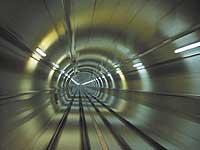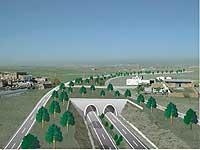Are we prepared to combat fires in tunnels?

One of the most important elements to take into account in case of fire in a tunnel is the ventilation system, which allows the exit of those trapped inside the tunnel. To verify the proper functioning of this system, it is essential to perform real tests.
In this sense, the LABEIN technology centre has presented the “Hot and clean smoke test”, having already carried out several tests in different tunnels of the Basque Country.
Clean hot smoke testThe aim of this essay is to generate a flow of clean gases at the same temperature as those that would occur in a real fire. In this way, it will be possible to analyze the behavior of these fumes in the ventilation system according to the predefined guidelines.
This test is done in two conditions: speed and cleaning. The trial cannot last longer than 8 hours. After this period, the tunnel must be opened so as not to overly hinder traffic. This test should leave the tunnel completely clean. In no case will the facilities and structure of the tunnel be dirty.
Txorierri corridor test
The first test was performed in the Txorierri tunnel. A hot smoke generator equipment was used to carry out the test, analyzing its development, calibration and protocols of use. This device emits a clean, colorless gas at a sufficient temperature to provoke its stratification.
In this test the gas flow was 20 m 3 per second, with a duration of 40 minutes. The fire power was 2.2 MW.
The fire was controlled thanks to the three cameras that recorded the evolution of the fumes. In all the sections in which the cameras were located, a column with reflective plates was placed. These plates were placed at three heights, which allowed to see the presence and movement of smoke.
Lezarri tunnel testLABEIN carried out on 30 October 2003 a new test of fire safety measures in the Lezarri tunnel of the A1 motorway.
This tunnel, of 1,253 meters of length, consists of two twin tubes of one sense. These tubes are joined by 5 transverse galleries. In addition, the tunnel has a longitudinal ventilation system with 10 fans per tube. In this type of system, once the fire has been detected, it is intended to immediately control the direction of the smoke, directing it towards the ceiling and opening it towards both directions (right and left) so that people leave the tunnel as soon as possible.
In many fires there is a dangerous Back-lyering effect. Smoke ascends through the tunnels and the ventilation system normally emits this smoke in one direction, towards the exit of the tunnel. But in many cases the smoke goes towards the entrance and down from the ceiling to the ground, which captures the people who leave.

This effect is called the Back-lyering effect. Researchers at the Labein center try to keep the smoke as high as possible by controlling the speed and direction of the ventilation system, although it is distributed in two directions (until the smoke takes the form of an umbrella) to somehow simulate this effect.
On the other hand, the Lezarri tunnel has a control centre in the direction of Bergara. There they collect the data of the tunnel sensors, have a control table of the ventilation system and communicate the tunnel with the control center through PA, signaling and light panels.
Results of the testsAccording to the technicians, this test fully covers the needs of the safety system for the control of hot gases from a real fire. In addition, it can be used in tunnels with different security systems. It should be taken into account that these trials are not intended to verify the structural behavior of the tunnel.
The test protocol is very flexible as it allows to configure a solution for each need: road or rail tunnels, unidirectional or bidirectional tunnels, longitudinal or transversal fans, etc. In addition, the fact that the tunnels are scarcely dirty, greatly reduces environmental pollution and drastically reduces cleaning costs.
In view of the results obtained so far, it is possible that the LABEIN technology centre will design and use safety level test systems in areas other than tunnels in the future.





